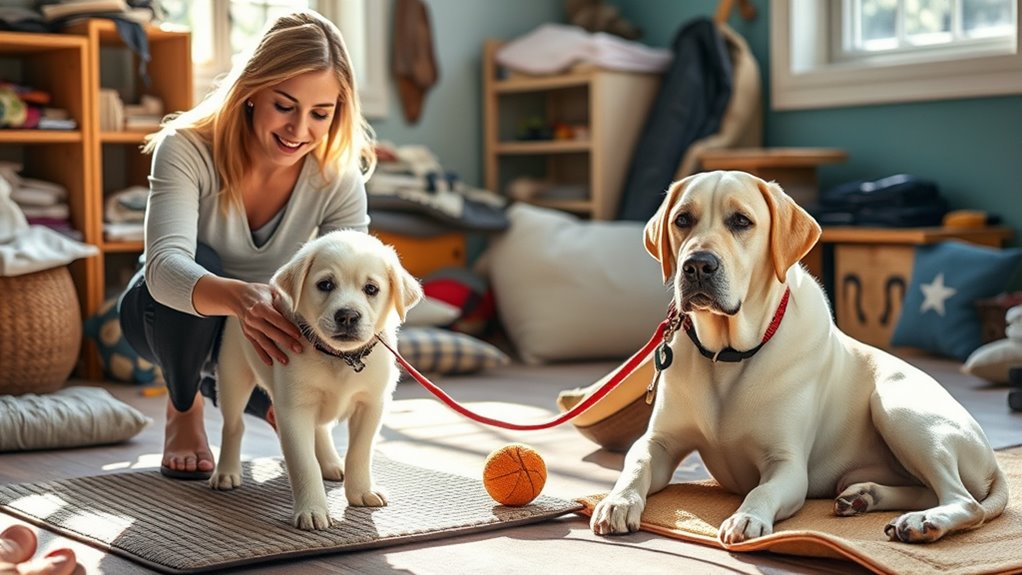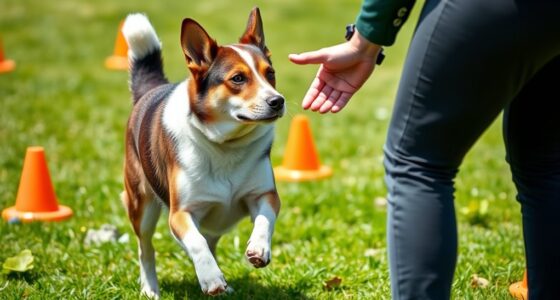To train dogs with disabilities like blindness or deafness, adapt your methods with specialized tools such as harnesses, vibrating collars, or mobility aids that support their needs. Use positive reinforcement consistently, focusing on building trust through gentle guidance and cues like touch or scent. Patience is key as progress may be slow. Combining assistive devices with tailored behavior strategies helps your dog gain confidence and independence—continue exploring how to make training both effective and compassionate.
Key Takeaways
- Use positive reinforcement and consistent routines tailored to each dog’s sensory needs.
- Incorporate assistive devices like tactile cues for deaf dogs or guiding harnesses for blind dogs.
- Gradually introduce new skills, pairing devices and techniques with praise to build trust and confidence.
- Focus on shaping behaviors through patience and adapting methods based on individual responses.
- Combine environmental aids with behavior modification to promote independence and reduce frustration.

Have you ever wondered how dogs with disabilities can learn new skills and adapt to their challenges? The truth is, with patience, creativity, and the right tools, you can help your dog thrive despite their limitations. One of the key aspects of training dogs with disabilities involves using assistive devices and behavior modification techniques. These tools and methods work together to enhance your dog’s independence and confidence.
Assistive devices are designed to compensate for your dog’s impairments. For example, if your dog is blind, a harness with a handle can help you guide them safely around obstacles. Vibrating collars or tactile cues can alert a deaf dog to your presence or to commands, facilitating better communication. Some dogs benefit from mobility aids like wheelchairs or carts, which enable them to move comfortably and participate in daily activities. These devices aren’t just practical; they also send positive signals to your dog that they can still engage with their environment. Introducing assistive devices should be gradual and positive. You want your dog to associate these tools with comfort and support, rather than fear or confusion.
Behavior modification plays a vital role in training dogs with disabilities. It involves shaping your dog’s responses through consistent, positive reinforcement, helping them adapt to new routines or overcome anxieties related to their impairments. For a deaf dog, this might mean rewarding eye contact or touch as a way to communicate. For a blind dog, guiding their nose to familiar scents can help build confidence and reduce frustration. You’ll need to be attentive to your dog’s responses and adjust your approach accordingly. Patience is essential because progress may be slow, but every small step counts. Reinforcing calm, confident behaviors encourages your dog to stay relaxed and engaged, even when they face sensory challenges. Additionally, understanding the 16PF traits of your dog can help tailor training methods to better suit their personality and communication style.
The key to effective training is understanding your dog’s unique needs and responding with empathy. Use consistent commands, expressive body language, and plenty of praise to reinforce positive behaviors. Remember, training isn’t just about teaching commands; it’s about building a trusting relationship that helps your dog feel safe and supported. When combining assistive devices with behavior modification, you give your dog the tools they need to navigate their world more effectively. With time and perseverance, you’ll see your disabled dog develop new skills, gain confidence, and enjoy a fulfilling life alongside you.
Frequently Asked Questions
How Do I Ensure Safety for Blind or Deaf Dogs During Training?
To guarantee safety for your blind or deaf dog during training, use clear visual cues for sighted dogs and scent markers for those with hearing impairments. Keep training sessions in a secure, familiar space to prevent accidents. Always supervise closely, and consider using gentle, consistent signals your dog can feel or see. This approach helps your dog stay safe while building trust and effective communication.
What Are Effective Communication Strategies for Deaf Dogs?
You might find that hand signals and tactile cues are highly effective for communicating with deaf dogs. Studies show these methods enhance understanding and strengthen your bond. Use clear, consistent gestures and gentle touch to signal commands or comfort. By practicing regularly, your dog learns to associate specific signals with actions, making training smoother. Remember, patience and positive reinforcement are key to building trust and ensuring your deaf dog responds confidently.
How Can I Identify Signs of Frustration or Anxiety in My Disabled Dog?
You can spot signs of frustration or anxiety in your disabled dog by paying close attention to their body language and emotional cues. Look for pacing, lip licking, yawning, or avoiding eye contact, which often indicate stress. Tense muscles, raised hackles, or a lowered tail can also signal discomfort. By observing these signals consistently, you’ll better understand your dog’s emotional state and respond with calming, comforting actions.
Are There Specific Toys or Tools Beneficial for Training Disabled Dogs?
You’ll find that toys for sensory stimulation, like textured balls or scent-based puzzles, really engage your disabled dog’s senses. Tools for assistance, such as harnesses, vibration collars, or tactile markers, make training easier and more effective. These specialized toys and tools help build confidence and encourage interaction. By tailoring these items to your dog’s needs, you foster a positive learning environment that supports their unique abilities and promotes their well-being.
How Long Does It Typically Take to Train a Dog With Disabilities?
Training a dog with disabilities varies, but typically it takes several weeks to months, depending on the dog’s specific needs and progress indicators. You’ll notice signs of progress through improved responsiveness to cues, increased confidence, and reduced anxiety. Patience is key, as consistent, positive reinforcement accelerates learning. Keep in mind that each dog’s training duration is unique, so celebrate small victories along the way to stay motivated and adjust your methods as needed.
Conclusion
Remember, where there’s a will, there’s a way. Training a blind or deaf dog requires patience, understanding, and adapting your methods, but the bond you build makes every effort worthwhile. By using gentle guidance, consistent cues, and plenty of positive reinforcement, you can help your furry friend thrive. Disabilities may present challenges, but they also showcase the true resilience and love dogs are known for. With dedication, you can turn obstacles into opportunities for growth and companionship.










